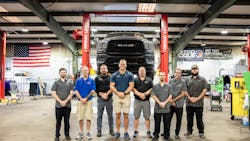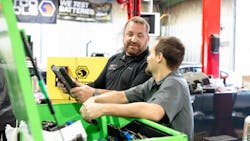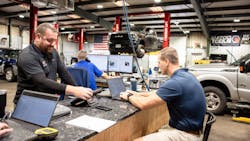Key Highlights
- Effective communication between technicians and advisors creates a thorough vehicle health report, increasing sales opportunities and customer trust.
- Utilizing video inspections and digital documentation bridges the gap between vehicle condition and customer understanding, reducing confusion.
- Internal tools like Google Chats and tablets streamline workflow, minimize interruptions, and ensure accurate, consistent information sharing.
- Training, including shadowing and peer reviews, enhances staff skills in diagnostics, communication, and translating technical details into customer-friendly language.
- Clear, honest dialogue and accountability are essential for building customer trust, maximizing repair opportunities, and ensuring shop profitability.
When technicians and shop advisors communicate effectively, the result is a well-rehearsed dance that provides an extensive health report of each vehicle that enters the bay. This baseline explores the good and the bad, including what’s working, what has seen better days, and what needs immediate attention.
In this routine process, the information that is relayed between the front and back of house not only makes for a thorough inspection, but an opportunity to convert possible maintenance issues for customers into sales.
However, when technicians and advisors fail to relay information effectively, it will appear as though both parties skipped the dress rehearsal. So, how do they work together to find a rhythm that keeps vehicles safe and customers informed?
Considering that 20% of respondents to the 2025 Ratchet+Wrench Industry Survey reported finding an average of $2,000 in opportunities per vehicle, the topic can have quite an impact on your bottom line. But if you’re part of the 22% who reported that you do not measure opportunities, it’s entirely possible that your shop is leaving money on the table.
To make the most of opportunities, the first step is ensuring your front and back of the house are in sync in identifying opportunities and communicating them to customers. How you choose to do that means developing a repeatable process that delivers accurate information every time.
The Intake Process
At most auto repair shops—including American Pride Automotive’s six stores across the Virginia Penninsula (including areas such as Williamsburg, Toano, and Yorktown)—the process begins with a test drive, says Billy Weston, chief technical training officer for the brand.
“We're looking for anything abnormal,” he explains. “Is the vehicle tracking straight down the road? How are the brakes performing? Are there any weird noises? Are there any drivability concerns that the customer may not have made us aware of or they weren't aware of themselves? We then proceed with bringing the vehicle into the shop and start racking it.”
Once inside, technicians continue the standard intake process with a thorough inspection that utilizes a DVI standard operating procedure via shop management software.
“This is a form that was created a few years back that outlines how and when maintenance and repairs should be recommended across all six of our stores,” Weston says. “Ultimately our goal is to be transparent with the customer and make sure that we are providing a consistent experience across all of our stores.”
In Fort Myers, Florida, vehicles at Legendary Auto & Truck Repair undergo a similar process, says Jason LaBonte, who is part owner of the chain that spans three locations. Their shops rely on a shop management system to document their DVIs—all while their technicians film the process. He stresses that they focus on providing a full report—not just the things that are wrong.
“We don’t just do photos and videos of the bad,” he says. “We also address a lot of things that are good on the vehicle because we want to give a good health report; but we also want to show the customer that, ‘Hey, these are some things that we found that were concerning’.”
Back of House Documentation
With cameras rolling, LaBonte says technicians address customers directly in showing the condition of their vehicle and then deliver the video right to their phone or inbox via a text message or email.
“What that does is it bridges the gap between the condition of the vehicle and the customer knowing the condition of the vehicle,” LaBonte notes. “We're not trying to lose the message in the translation because usually the technician will tell the service advisor, and the service advisor will have to build a quote and then relay that message to the customer. Instead, we're sending these inspections directly to the customer's phone.”
He adds that while he does not promote technicians coming out of the service area to talk with customers, he advocates them delivering such a clear message in the videos that it eliminates any confusion about the condition of the vehicle.
“We want the technicians to answer any and all questions and leave nothing on the table, as far as ‘Well, I don't understand’ because the lack of understanding is going to make people not want to buy essentially,” he adds.
Internally, technicians and shop advisors communicate via Google Chats if diagnostics need clarification. This eliminates both parties from being distracted or pulled off tasks to answer questions, he notes. That’s not to say they never talk, but it streamlines communication and workflow.
“It saves a lot of the service writer walking out in the shop, interrupting the technician, the technician walking up into the office, interrupting the service writer,” LaBonte explains. “The service writer is answering phones. He's got customers in front of him. He's got parts being delivered. If a technician comes up and asks him a question and interrupts him, he has to figure out where he was at and get back to doing what he was doing. And same thing with a technician. If a service writer is constantly leaving his post to go out and talk to a technician, he's interrupting the technicians.”
Similarly, American Pride’s technicians utilize tablets to fill out DVI templates which are then sent to service directors for review. They, too, rely on tablets equipped with WhatsApp chats to disseminate information from one department to another.
Bridging the Gap Internally
And while the best efforts are made to stave off gaps in communication, the inevitable reality is that sometimes things are unclear and other times, they are misunderstood.
For times when more explanation is needed on a particular job, the shop foreman will step in to assist, Letendre says.
“Whenever there's an issue with understanding, let's say it's a complex job that requires timing components or internal engine repair, the immediate directive is to go to the shop foreman,” he notes. “Now the shop foreman will break down the repair for the advisor to make sure they understand it.”
For Legendary Automotive, documentation is the backbone of their communication, LaBonte says. If the video inspections, photos, and the narrative they pass along to the service advisors are not clear and do not address all the concerns of a customer, internal chats via tablets help to keep both technicians and advisors on the same page and on task.
“We're big on communication. If it's not written, it didn't happen,” LaBonte says. “We can't do the verbal back and forth, so everything gets messaged.”
Through proper documentation, inspection, and following the proper workflow channels, LaBonte notes, the shop has a 100% close ratio with an average repair order between $1,650 and $1,800.
Tips for Training
To get everyone on the same page, thorough training is essential, LaBonte says, especially when it comes to new technicians. For new hires and those without DVI experience, a two- or three-week shadowing period of more experienced technicians is mandatory.
Once technicians are turned loose to conduct their own inspections, service advisors keep an eye on reports and make note of missing details.
“I'm using my service advisors to quality control the inspection from the new guy, essentially because they know what to look for,” he says. “If we have a new guy doing inspections and they’re seeing that things that are different, they'll say, ‘there's not a lot of good photos. He didn't take any videos. He marked here that there's a loose ball joint, but there's no video’. Anything that's got free play. It needs a video.”
Like American Pride’s chain of command, the shop foreman will also step in to assist in the back and forth between a technician and advisor if necessary.
While shadowing has a long history in learning an occupation, Letendre recommends not just limiting it to the job a hew hire will be expected to perform. Instead, he believes technicians should shadow service advisors and vice versa.
“Technicians usually start at a private garage, or they learn from their dad, or they learn with a buddy, and then they go to a trade school, and they become apprentices, and they have a pretty set path of advancement,” he explains. “But at no point along that path does anybody ever say, ‘hey, you need to see what this other side looks like, so that you can better understand how what you put on paper, what you put on a digital inspection, translates to the front of the business’.”
Conversely, he adds, service advisors should be expected to do the same, even if they worked in a similar role previously.
“Allow those front counter staff to spend a couple of days in the bay before they put them out there, even if they’ve got 15 years in the business,” he encourages owners. “If you're able to sit in each other's seat, wear each other's shoes for a little bit, it gives them a mutual respect for the role. But you can't support your teammates if you don't know what your teammates are doing.”
For technicians who are struggling to communicate, Letendre recommends inviting them to decode one another’s work. He says the process serves as a peer review and allows them to see what’s missing from their own reports that’s hindering information from being delivered to customers.
“They'll usually come to a self-realization that they're missing a piece, and they're able to self-correct once they see it from another person's perspective,” he says.
Presenting Information to the Customer
Once the diagnostics have been determined and documented, they are passed along to the service advisors for review.
For Legendary Automotive, service advisors use tracking information from the photos and videos sent via text to see how much time the customer dedicated to examining the report. They then follow up with a phone call to answer questions and attempt to close the sale.
“I don't want to come off as though I don't think a lot of service writers are great with the automotive side of things, but we really need to treat service advisors to what they are—they’re salesmen,” LaBonte says. “They need to focus on sales. They need to focus on the numbers, and they need to focus on the expectation of when the vehicle is going to be ready. They don't have a lot of the technical knowledge that the technicians do.”
For this reason, Legendary relies on the inspection to paint the picture with the technician’s narrative before the service advisor steps in.
Meanwhile, America Pride takes a different—yet similarly successful—approach.
“Our service advisors and our service directors have a multi-screen set up in front of them with an indicator,” says Chris Letendre, client facing training officer for American Pride.
“Once a vehicle has been reviewed, it shows up with a bell and says, ‘your next review is ready to go’. So, all the data they've just received now comes up in front of them.”
Letendre says this is where training for advisors really comes into play in teaching client staff how to convert technical jargon into human language, which he terms 80/20 English.
“Eighty percent of our clients know roughly 20% of the current terminology,” he explains. “And if we're not conveying the information to them in ways they can understand, we're not really communicating with them, we're just we're showing them a raw data that they can't interpret.”
Using AI and internal training, service advisors spend time preparing the report for their client’s review by breaking down the language barrier and converting it into a more digestible, conversational piece. And before it is sent along to the customer, it is reviewed by at least two team members internally. This means either by a second advisor or the store director.
“Whether you've been doing this for 10 years or 10 months, every single DVI before we send it to a client, we make sure a second person reviews it first,” Letendre stresses.
This is not only to ensure that the information is clear, but that the diagnostics are accurate. After all, Letendre points out, all the semantics in the world sometimes can’t make up for a misdiagnosed repair or replacement.
He cites a scenario that occurred about six months ago in which the technician determined a vehicle needed some timing components replaced. However, he explains, a breakdown in communication fell short of explaining the age of the vehicle, the condition, and the fact that it had 190,000 miles on it. During the two-man audit of the report, the team determined the vehicle did not need repair work but a complete engine replacement. Unfortunately, the repair information had already been relayed to the customer, who was disappointed in the news, to say least.
“They were so dialed in on it being a repair that when we turned around and said, ‘actually, the correct way to repair this is going to [cost much more],’ it just blew everything,” Letendre recalls. “There was just no way to correct from there. They became so disappointed that they decided to scrap the whole thing.”
He adds that injecting processes that review exchanges between parties may not eliminate all issues in the relay of information, but it’s a step in the right direction.
“Most of the time, we find if there's ever a fall down—whether it's front of the house, the back of the house, back to front, front to client—it’s always communication,” he asserts.
Choose Your Words Wisely
And keep in mind that training isn’t just for internal communication. In fact, Letendre points out that even the words you use to explain a job to a customer could have an impact on the success of a sale.
“Training this afternoon is to eliminate the word 'find’ from everybody's conversation vocabulary because we discovered when we use the word ‘found’, people imply that we're looking for things on their car,” he notes. “So, we're always training even down to word choice and everything else here to make sure our clients are really feeling well taken care of and advocated for.”
With the proper dialogue and conversation tools, Letendre estimates American Pride finds recommendations for clients on 90% of the vehicles that are brought in for service. He says the average opportunity (the average estimate presented to each client along with their DVI) in 2024 was approximately $2,100.
LaBonte agrees whether from a technician or a service advisor, customers must be able to trust the advice they’re given regarding the safety of their vehicle. He adds accountability goes a long way in earning their business.
“You have to have good moral fabric in your in your organization, and integrity and be able to tell the customer, ‘Listen, we stand behind our diagnostic and we stand behind everything we do’,” he says. “It’s a different generation right now for auto repair, so having good communication and training everybody front to back is just super important to being successful in this business.”
Room to Grow
With shop owners reporting an average repair above $600 and the average opportunity per vehicle reported at $1,500 or more, there’s room to increase the average sale per vehicle. Here’s a look at the average opportunity per vehicle as noted in the 2025 Ratchet+Wrench Industry Survey Report.
AVERAGE OPPORTUNITY* PER VEHICLE
|
Below $800 |
7% |
|
$800-$999 |
13% |
|
$1,000-$1,100 |
9% |
|
$1,200-$1,499 |
14% |
|
$1,500–$1,999 |
12% |
|
$2,000 and above |
20% |
|
Does not measure |
22% |
|
Does not know what this is
|
3% |
*average amount of work found on a car—sold and unsold
About the Author
Christine Schaffran
Editor-in-Chief
Christine Schaffran is the Editor-in-Chief for Ratchet+Wrench magazine at Endeavor B2B. She is an award-winning journalist, having covered both commercial and industry magazines and newspapers during her career. She previously served as Editor-in-Chief for another publisher for 17 years prior to joining Endeavor. When she's not spending time with her husband and son, you'll find her in the kitchen experimenting with new recipes and delicious dishes to try.
Don't miss Christine Schaffran's next article. Sign up for Ratchet+Wrench's Insider and This Month in Ratchet+Wrench's newsletters.






